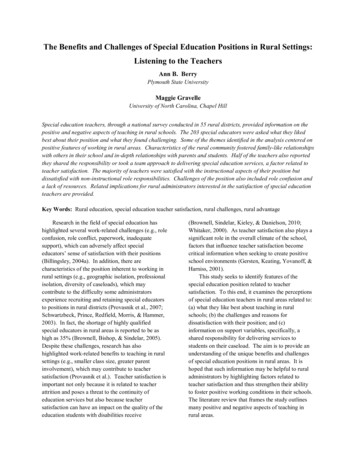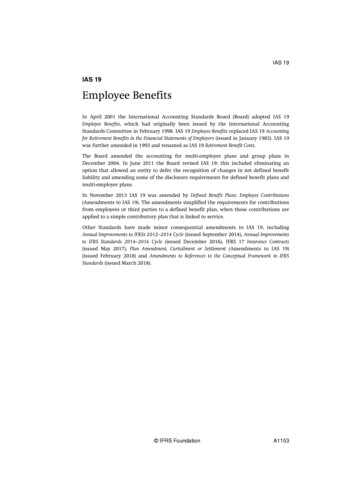
Transcription
The Benefits and Challenges of Special Education Positions in Rural Settings:Listening to the TeachersAnn B. BerryPlymouth State UniversityMaggie GravelleUniversity of North Carolina, Chapel HillSpecial education teachers, through a national survey conducted in 55 rural districts, provided information on thepositive and negative aspects of teaching in rural schools. The 203 special educators were asked what they likedbest about their position and what they found challenging. Some of the themes identified in the analysis centered onpositive features of working in rural areas. Characteristics of the rural community fostered family-like relationshipswith others in their school and in-depth relationships with parents and students. Half of the teachers also reportedthey shared the responsibility or took a team approach to delivering special education services, a factor related toteacher satisfaction. The majority of teachers were satisfied with the instructional aspects of their position butdissatisfied with non-instructional role responsibilities. Challenges of the position also included role confusion anda lack of resources. Related implications for rural administrators interested in the satisfaction of special educationteachers are provided.Key Words: Rural education, special education teacher satisfaction, rural challenges, rural advantageResearch in the field of special education hashighlighted several work-related challenges (e.g., roleconfusion, role conflict, paperwork, inadequatesupport), which can adversely affect specialeducators’ sense of satisfaction with their positions(Billingsley, 2004a). In addition, there arecharacteristics of the position inherent to working inrural settings (e.g., geographic isolation, professionalisolation, diversity of caseloads), which maycontribute to the difficulty some administratorsexperience recruiting and retaining special educatorsto positions in rural districts (Provasnik et al., 2007;Schwartzbeck, Prince, Redfield, Morris, & Hammer,2003). In fact, the shortage of highly qualifiedspecial educators in rural areas is reported to be ashigh as 35% (Brownell, Bishop, & Sindelar, 2005).Despite these challenges, research has alsohighlighted work-related benefits to teaching in ruralsettings (e.g., smaller class size, greater parentinvolvement), which may contribute to teachersatisfaction (Provasnik et al.). Teacher satisfaction isimportant not only because it is related to teacherattrition and poses a threat to the continuity ofeducation services but also because teachersatisfaction can have an impact on the quality of theeducation students with disabilities receive(Brownell, Sindelar, Kieley, & Danielson, 2010;Whitaker, 2000). As teacher satisfaction also plays asignificant role in the overall climate of the school,factors that influence teacher satisfaction becomecritical information when seeking to create positiveschool environments (Gersten, Keating, Yovanoff, &Harniss, 2001).This study seeks to identify features of thespecial education position related to teachersatisfaction. To this end, it examines the perceptionsof special education teachers in rural areas related to:(a) what they like best about teaching in ruralschools; (b) the challenges and reasons fordissatisfaction with their position; and (c)information on support variables, specifically, ashared responsibility for delivering services tostudents on their caseload. The aim is to provide anunderstanding of the unique benefits and challengesof special education positions in rural areas. It ishoped that such information may be helpful to ruraladministrators by highlighting factors related toteacher satisfaction and thus strengthen their abilityto foster positive working conditions in their schools.The literature review that frames the study outlinesmany positive and negative aspects of teaching inrural areas.
Positive Aspects of Teaching in Rural SchoolsRural school communities have many positivequalities that can influence the satisfaction of specialeducation teachers. Rural teachers, for example,often report positive relationships with their studentsand parents, as well as an appreciation of the rurallifestyle (Davis, 2002). Provasnik and her colleagues(2007), using data provided by the National Centerfor Educational Statistics (NCES), found thatcompared to teachers working in urban locales, alarger percentage of teachers working in rural areas,were satisfied with their class size, their students’behavior, and the support they received from parents.Students in rural districts more frequently came toschool prepared to learn and had fewer studentbehavior problems. Parents were more frequentlyinvolved in parent and teacher conferences andschool events.Research in rural education has highlightedadditional qualities found in small, rural schools thatpositively impact teacher satisfaction. Malloy andAllen (2007) studied one rural elementary schoolwith a low teacher attrition rate (6% versus 20% inthe district and 19% in the state). The staff fostered afamily-like atmosphere (e.g., making personal phonecalls to each other in times of stress). The schoolemphasized collaboration among staff (e.g., teamteaching, mentoring, peer coaching and evaluation)and administrators were reported as being caring andapproachable. The non-threatening environmentencouraged questions from new faculty and promotedopportunities for teachers to discuss issues withexperienced colleagues. Similarly, in one ruraldistrict in Florida, teachers stated the sense ofknowing each other well was the quality of workingin a small school community they enjoyed most(Huysman, 2008). The presence of a cohesive schoolcommunity was important for these teachers workingin their small, rural school.Nagle, Hernandez, Embler, McLaughlin, andDoh (2006), investigating 13 high schools with highlevels of staff stability in three rural states, found thatan attitude of collective responsibility within theschool was also important to teacher satisfaction.Students with disabilities were often educated in thegeneral education classroom and the staff shared theresponsibility for educating all students, both specialeducation and general education students. Teachersof general and special education described closerelationships with each other and a high degree ofcollaboration. This was facilitated by a sharedplanning time for teachers and team meetings once aweek. Building administrators were also veryinvolved with special education processes andsupported a positive working relationship betweenteachers.Challenges of Teaching in Rural AreasThe remote locations and geographically largedistricts of some rural areas pose distinct challengesfor special educators. In rural special education, thelow incidence of special needs populations can meansmaller caseloads, but can also mean teachers are oneof few special educators in their school or district, oreven the only special educator providing services inseveral schools. Special educators in remotelocations frequently report professional and socialisolation as a challenge of their position (Collins,1999). Additionally, the transition to a rural area,where the social and cultural activities typicallyassociated with larger urban districts are notavailable, can be difficult for new teachers(Bornfield, Hall, Hall, & Hoover, 1997).The characteristics of the special needspopulation create additional challenges for ruralspecial educators. In some small rural schooldistricts, special education teachers provideinstruction to students in kindergarten through 12thgrade across a variety of subjects (Schwartzbeck etal., 2003). Special educators are often asked toaddress a wide variety of student needs and disabilitycategories in rural schools, resulting in a need forteachers to work outside of their typical training andexpertise (Brownell et al., 2005).Many rural schools operate within a morerestricted budget because of a lower tax base in theseareas (Monk, 2008). Limited operating budgets inrural schools present additional challenges for ruralspecial education teachers. Teachers may need tomake do with fewer materials and resources due tobudget constraints. Rural schools may struggle toprovide the specialized services required byindividualized programs. As a result, small schoolsmay be forced to consolidate services or hire outsideagencies to provide services for their students withspecial needs (Hodge, & Krumm, 2009).
Historically, teachers in rural areas have experiencedlower pay scales, fewer support networks, and limitedprofessional development opportunities because oftheir schools' limited resources (Collins, 1999;Ludlow, Conner, & Schechter, 2005).Further, the federal mandates of No Child LeftBehind (NCLB, 2001) for student progress can bediscouraging for special educators in rural areas.Despite the teachers’ effectiveness, a small numberof special needs students can create artificialvolatility in achievement scores, hindering theschool’s ability to meet adequate yearly progress(AYP). Being marked as an In Need of Improvementschool can create a demoralizing environment forspecial educators. NCLB sanctions (e.g., fewerfederal funds, reassignment of money, or the optionof school choice) can strain an already stretchedschool budget as administrators struggle to recruitand compete with the better salaries, student services,and teacher programs found in other parts of the state(Brownell et al., 2005; Jimerson, 2005).It appears that special education teachers whowork in small and rural communities may have fewerprofessional sources of support available to them thusincreasing their sense of professional isolation. In arecent national study, researchers examined therelationship of work-related support to specialeducation teacher satisfaction in rural districts (Berry,2012). One key support variable, the supportprovided by other special educators, was not alwaysavailable. However, teachers who were resourcefulhad a wider network of support from availablesources such as administrators and general educationcolleagues; these teachers reported greater levels ofsatisfaction. Job satisfaction was also found toincrease if others in the school understood the specialeducator’s role and responsibilities and if othersshared in the responsibility of providing services tostudents with disabilities.In summary, research has indicated that small,rural school environments have positive qualities andapparent challenges that can influence specialeducation teachers’ satisfaction with their position.However, only a small number of studiesinvestigating factors related to teacher satisfactionspecifically focus on the rural special educationteacher. Studies that have investigated rural teacherswere generally conducted in a centralized region orsingle state. Research conducted on a national scalethat analyzed rural special education teachers’perceptions of their positions would provide vitalinformation related to teacher satisfaction.This study was guided by the following researchquestions: What do special education teachers reportthey like best about their current position in ruralschools? What do they perceive as the challenges ofworking in rural schools? What do teachers cite asreasons for dissatisfaction with instructional or noninstructional aspects of their job? Do specialeducation teachers state they shoulder the entireresponsibility of educating students with disabilitieson their caseload or do they share this responsibility?What are the contributors to this perception?MethodDuring the 2008-2009 and 2009-2010 schoolyears, special educators from a national sample ofrural school districts provided data for this study.Data reported here were collected from responses toopen-ended questions related to special educationteachers’ perceptions of satisfaction and support intheir positions. These questions were part of a largersurvey with quantitative items that have beenreported separately (Berry, 2012). The followingsections outline procedures for sample selection,teacher characteristics, survey administration, anddata analysis.Sample SelectionParticipants were special education teachers fromrural school districts in 33 states. Rural districts wereidentified in the following way: first regular publicschool districts were identified from the NCESCommon Core of Data (Version 1a: NCES, 2006).Districts were then identified as rural in several ways:(a) their eligibility in either the Rural EducationAchievement Program or the Rural and Low-IncomeSchools Program; (b) they were designated with arural NCES metro-centric code (i.e., 7 or 8); or (c)had a rural NCES urban-centric code (i.e., 41 forrural fringe, 42 for rural distant, or 43 for ruralremote).Fifty-five districts were then randomly selectedfrom these rural districts. Sixteen of the districtswere in rural fringe locale codes and located near anurban cluster, 23 were categorized as rural distant
(i.e., 5 to 25 miles from an urban area) and 16 were inrural remote areas (i.e., more than 25 miles from anurban center). Additional characteristics of thedistricts are outlined in Table 1.Researchers utilized district websites andadministrators to identify all special educationteachers in each district. A letter of introduction wassent to each special education teacher explaining theaims of the study. Teachers were then contacted bytelephone and invited to participate in the research.A cap of 10 teachers per district was imposed toavoid over-representation of the sample by largerdistricts.From a pool of 522 special education teachers inthe 55 districts, 159 were found ineligible eitherbecause they were not special educators (e.g., workedas a paraprofessional or school psychologist) or thecap of teachers had been reached for the district.Interviewers were able to contact 243 teachers bytelephone, resulting in a response rate of 67% (i.e.,243/363). A total of 204 teachers agreed toparticipate in the study for a participation rate of 84%(i.e., 204/243; Berry, 2012).Table 1Composition of District Sample (N 55)CategoryNumber ofdistricts enumber ofschools(range)Number of districts inNCES local codeRemoteDistantFringeSmall Rural SchoolAchievement Program20(36%)373(72 – 1,020)2.3(1 – 6)7103Rural and Low-IncomeSchools Program11(20%)2,719(632 – 7137)7(3 - 14)272NCES Rural24(44%)2,229(131- 11,047)4.8(2 - 17)7611Teacher and Position CharacteristicsAs can be seen in Tables 2 and 3, specialeducation teachers in this sample were typical ofthose found in other rural research (Bornfield etal.,1997; Davis, 1992). The majority of teachers(62%) had lived in their rural area for 16 years ormore, and nearly half were teaching in a schoollocated in the same general area as the place wherethey grew up. Teachers held certifications and taughtin more than one grade level. Most (80%) had smallcaseloads (i.e., fewer than 20 students) with anaverage of 15 students. Teachers in the sample had awide range of experience. Most teachers (62%) heldtheir state’s highest level of certification in specialeducation and were considered highly qualified. Halfof the teachers had been teaching in the field ofspecial education for more than 10 years, and 33%more than 16 years (Berry, 2012). One rural teacherhad been working in the field of special education for32 years. In some districts the special educationteacher was the only special educator in the districtand divided his/her time between two or threebuildings, whereas in other districts the specialeducator was one of many special education teachersin a large consolidated district.
Table 2Teacher Demographics (N 203)CharacteristicM (SD)New1-2 yrsBeginning3-5 yrsEarly6 -10 yrsMature11-15 yrsVeteran16-20 yrsYears in position7.8 (.8)30%27%18%10%16%Years in specialeducation12.9 (9)10%16%24%14%33%Years living in ruralarea22.2 (15)7%8%16%7%62%20 – 2913%30 – 3923%40 – 4927%50 - 5929% 18%Classroomconsultant4%20-2510%Age in years43 (11)Table 3Position Characteristics (N 203)% teachers withK–5special education60%certificationSelfPrimary instructionalcontainedsetting25%Students on caseloadMean 15.2 (SD 8)2-1030%11-1527%16-2023%Grade levelK–554%6-841%9 – 1225%Highest level of SpEdcertification for theirstateYes62%No30%Don’t ative14%Other3%Highest level ofeducationTeacherlicensureGrew up inYesNorural area48%52%Note: BA/BS Bachelor degree; MS/MEd Master degree26-4010%
ProceduresSeven interviewers conducted phone interviewsof 35 to 90 minutes in length with the teachers.Interviewers were two researchers from the NationalCenter on Rural Education Support (NCRES) whohad extensive training and experience in surveyimplementation, and five university graduateassistants. Interviewers were trained prior to the startof the study and three periodic checks for drift withthese procedures were conducted over the ninemonths of the study. Reliability rates for adherenceto the script and accuracy of response recording was95% or higher (Berry, 2012). During the interview, ascript was read and teacher responses were typeddirectly into a computer database. Additionally,interviewers were trained to verify that the recordedanswer accurately represented the teacher’s views byreading the recorded response aloud (i.e., memberchecking) following the teacher’s response to eachitem. If teachers provided additional information toexpand or clarify their responses, the interviewerwould type that information into the database.Data AnalysisCoding for the teacher responses was developedin a structured and logical way. Data were compiledby question in a table containing each teacher’sresponse. One researcher from NCRES and onedoctoral student coded data into topic areas generatedfrom prior research in rural special educationinvestigating special education teacher jobsatisfaction (Downing & Peckham-Hardin, 2007;Gehrke & McCoy, 2007; Malloy & Allen, 2007;Nagle et al., 2006). Categories emerged from theteacher responses (e.g., small school size,relationship with staff, relationship with students,paperwork), as researchers accounted for newrelationships. Data were then re-categorized asconnections both within and across items developedand new constructs emerged (e.g., sharedresponsibility with general educators, related serviceproviders). This across-case analysis method wasused to identify pervasive patterns and themes (Miles& Huberman, 1994). The code number(s) for eachcategory were recorded beside each teacher’sresponse.To assure that open-ended responses were codedwith reliability, the two coders independently codedall responses from a subset of randomly selecteddistricts. The coded responses for these districts werecompared and inter-coder reliability (i.e., number ofagreements divided by the total number ofagreements plus disagreements) was 93% percent.Differences in coding were discussed and aconsensus was reached. The remaining districts werethen coded independently. Subsequent reliabilitychecks ranged from 90 to 97% agreement with anaverage of 94.5%. Descriptive statistics werecompiled based on the frequency and variety ofteacher responses to address the research questionsunder investigation.FindingsSpecial educators in 55 rural districts conveyedto researchers what they liked best and what theyfound challenging about teaching in specialeducation. Additionally, teachers reported on factorsrelated to their satisfaction and dissatisfaction withtheir positions.What Teachers Liked BestTeachers talked about many aspects of theirschool and community when asked what they likedbest about being a special educator in a small andrural school. Some of the major themes identifiedwere positive characteristics generally associatedwith being a special education teacher whereas otherswere characteristics of being a teacher in a ruralschool.Teaching in special education. Some of theteachers (14%) talked about positive aspects ofworking in the field of special education. Forexample, one teacher remarked, I like working insmall groups and learning each of my kids learningstyles in order to make the curriculum fit with theirown unique ways. These teachers enjoyed watchingtheir students make progress from year to year. Ienjoy working with this population of students,explained one teacher. “I feel I can really make adifference and improve their lives, whatever theirdisabilities.
Teaching in a rural school. The majority of theteachers (86%), however, when asked about whatthey liked best about their special education position,discussed aspects of the position related to teachingin a rural school. Teachers indicated that the smallersize of their rural community made possible positiverelationships with others in their school community,with their students’ parents, and with their students.Almost one third (31%) of the special educationteachers conveyed a family-like, supportivecommunity in their school. The staff is a very bigsupport to each other through personal andprofessional crisis, said one teacher of students withsevere disabilities. Everyone works together like ateam for a common goal. There is a lot of helpingeach other out in our school. Another teacheragreed: I like the feeling of being connected toeveryone because it is small enough. You seeeverybody and have to work with everybody.The special education teachers talked aboutforming close bonds with staff and these relationshipsprovided a sense of professional support, whichteachers appreciated. One teacher’s remarkrepresents this group.I love this job after being in a big district for 15years and how impersonal it was there. There issomething about this small district that is caringand supportive and you get the sense that we areworking together. We are very lucky in thisschool, [there is a] very supportiveadministration and special ed[ucation] staff. It'sall about the kids and not about the scores. It'slike a family rather than a corporation.A climate of acceptance was reported, which hada positive effect on student interactions. Forexample, one elementary teacher remarked:The acceptance of my students by everyone in theschool [is what I like best]. I love the feelingthat your school is like a small family or smallcommunity, and everyone is supportive andaccepting of the kids with disabilitiesspecifically. I go out to recess and I can't tellwhich kids are mine. I taught in a larger schoolnear [name of large city] and it wasn't like thatat all It is a really good experience here.The small size of the school also lent itself to anin-depth, personal knowledge of the students andtheir families. Twenty-eight percent of teachercomments communicated the opportunity in a ruralschool to watch students grow up from year to year,and see them in a variety of academic and nonacademic contexts. You get to know the kids and thefamilies really well in a small town, remarked oneteacher in this group. That is really nice. I thinkbeing in a city school this would be more difficult.Another teacher had similar comments.I develop a good strong relationship [withstudents], as I have them for 2 to 3 years and geta chance to be part of their lives. I am asurrogate mother and a friend. I also get toknow the parents really well. This year theyhave been supportive. In the larger district Ididn't have this type of rapport with parents.Here, they stop by or you see in the hallway. Wetalk in the parking lot at the store. It's neat.One teacher briefly summarized the familyatmosphere that can be part of a rural school: I knowthe entire school, every face, every name. Thesepositive aspects of working in a small and ruralschool also translated to sustaining teachers in theirpositions. One fourth grade resource room teachercommented:I think the reason I have been a specialeducation teacher for 26 years is because of theemotional support and friendships that are herein this school. Probably the reason I have beenhere this long is because of the friendships withthe other teachers that extend beyond myprofessional relationships at school.Some teacher comments (16%) discussedpositive aspects of working in a rural area. The kidsare more considerate and anxious to learn here.They are hardworking and there is not a lot ofcompetition among them about clothing or socialstatus. [There are] less behavioral concerns than youwould probably see in a city school. Half of thespecial education teachers had been raised in theirrural area and so personal ties contributed to schoolpride and a sense of community. As stated by oneteacher, I graduated from this school. It is home.Challenges to the PositionWhen special educators were asked specificallyabout the challenges they encountered being a specialeducation teacher in a rural school, several majorthemes emerged from the data. Teachers raisedissues widely acknowledged by special educators in
general (e.g., parents, role responsibilities,paperwork, testing, the lack of time) and some issuesspecific to a rural context.Teaching in special education. One of the mostfrequently mentioned challenges (21%) involvedstudents’ parents. Parents are one of my biggestchallenges, said one teacher of students withbehavior disorders. She continued:You can help them with the 6 hours that you havethem, but you can’t do much about the 18 hoursthat you don’t have them. So much of what thesekids come to school with is dependent on whathappens at home.Seventeen percent of special education teachers’comments concerned the responsibilities of their job.As one elementary resource room teacher noted.Scheduling [is a challenge] - getting to see all thekids in the time you need to see them so you arenot pulling kids from the things they need to bethere for in the regular classroom. It’s anightmare.The teachers expressed frustration with the lackof support provided by general education teachers.Support from the general ed[ucation] teachers islimited, one teacher said. Some teachers don't feelmy kids should be in their classroom if they are notable to do everything the regular education studentsdo. Some of the frustration was related to poorlydefined roles and responsibilities in the generaleducation classroom. Typical comments were, Coteaching it is not easy. Educational views and theways that you teach can clash.A few (8%) of special educators commented onfederally imposed responsibilities: paperwork, stateassessments, and meeting required benchmarks. Oneresource teacher said:Meeting the fantasy of NCLB [is the biggestchallenge]. We just took our statewideassessment, and we were listed as a failingschool because of my students. A six-month gainis a big deal in my experience, but because theydidn’t make 3 years growth, I didn’t do my job.It is discouraging.Fifteen percent of teachers’ comments referencedthe lack of time or the lack of staff to adequatelyperform the duties of the special education positionand meet students’ needs. The lack of help and time[are challenges]. If the caseloads were smaller, andyou had more time to go into classrooms and workwith students more, that would be helpful.Teaching in a rural school. Some of thechallenges mentioned were specifically connected toteaching in a small and rural school (26%). Thesmall size of the community contributed to thedifficulty special education teachers had separatingpersonal and professional lives. It’s a small town andrumors spread, commented one teacher, so thoselines get blurred professionally and confidentiality isa little harder. Teachers discussed the professionalisolation created by teaching in a rural district withlarge distances to travel to get to trainings. Teachersvoiced concerns about inadequate school resources:services, programs, staff, combined classrooms, andlarger caseloads. As one resource room teachercommented, Because you are stretched for time youcan’t be there the way you want to. I am the onlyspecial educator in the building. Another teacher ofa self-contained classroom explained:The diversity in the classroom [is a challenge]. Ihave LD, BD, MR, and autistic with oneassistant. It is very difficult as it is hard to dealwith all those classifications and personalities inone classroom. You don’t have the options thatmight be available in a larger district. You’vegot to take care of it yourself.A small percent (2%) of special educators raisedconcerns about low salaries.Even though the smaller size of the school meantlimited budgets, teachers also commented onproviding services to students, despite limitedfinancial resources. A fifth grade teacher’s remarkwas representative:Our special education coordinator is veryhelpful For example we have a student whohas a hearing impairment and we are getting anamplifying system for that student. Some peoplemight think that type of thing might not happenin a small school like we have. It might take awhile, but whatever a student might need, we tryreal hard to provide that.SatisfactionSpecial education teachers’ responses aboutsatisfaction spanned instructional and noninstructional areas of their position.
Satisfaction with instructional aspects. Mostof the special education teachers (89%) indicated thatthey were either satisfied or strongly satisfied withthe instructional aspects of teaching and deliveringservices to students on their caseload. Within thegroup who were dissatisfied, teachers providedseveral reasons for dissatisfaction, includingworkload demands (4%) and not enough time to meetthe demands of the role (2%). For example, onemiddle school teacher stated, I feel the kids needmore time to work on their skills. I just don't getenough time with them.Satisfaction with non-instructional aspects. Alarge majority (67%) of the special educationteachers indicated they were dissatisfied with thenon-instructional aspects of teaching. Many teachers(43%) specifically mentioned the paperwork involvedwith the job. Paperwork! said one teacher, whosecomments repre
University of North Carolina, Chapel Hill. Special education teachers, through a national survey conducted in 55 rural districts, provided information on the . district in Florida, teachers stated the sense of . In some small rural school districts, special education teachers provide instruction to students in kindergarten through 12th











